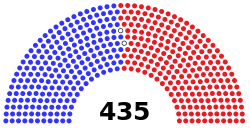
United States House of Representatives
Lower house of the United States Congress / From Wikipedia, the free encyclopedia
Dear Wikiwand AI, let's keep it short by simply answering these key questions:
Can you list the top facts and stats about United States House of Representatives?
Summarize this article for a 10 years old
The United States House of Representatives is the lower chamber of the United States Congress, with the Senate being the upper chamber. Together, they comprise the national bicameral legislature of the United States.
United States House of Representatives | |
|---|---|
| 118th United States Congress | |
 Seal of the House | |
 Flag of the United States House of Representatives | |
| Type | |
| Type | |
Term limits | None |
| History | |
New session started | January 3, 2023 (2023-01-03) |
| Leadership | |
| Structure | |
| Seats | 435 voting members 6 non-voting members 218 for a majority |
 | |
Political groups | Majority (221)
Minority (212)
Vacant (2) |
Length of term | 2 years |
| Elections | |
| Plurality voting in 46 states[lower-alpha 1] Varies in 4 states | |
Last election | November 8, 2022 |
Next election | November 5, 2024 |
| Redistricting | State legislatures or redistricting commissions, varies by state |
| Meeting place | |
 | |
| House of Representatives Chamber United States Capitol Washington, D.C. United States of America | |
| Website | |
| www | |
| Rules | |
| Rules of the House of Representatives | |
| This article is part of a series on the |
| Politics of the United States |
|---|
 |
|
|
|
|
|
|
|
The House's composition was established by Article One of the United States Constitution. The House is composed of representatives who, pursuant to the Uniform Congressional District Act, sit in single member congressional districts allocated to each state on the basis of population as measured by the United States census, with each district having one representative, provided that each state is entitled to at least one. Since its inception in 1789, all representatives have been directly elected, although universal suffrage did not come to effect until after the passage of the 19th Amendment and the Civil Rights Movement. Since 1913, the number of voting representatives has been at 435 pursuant to the Apportionment Act of 1911.[1] The Reapportionment Act of 1929 capped the size of the House at 435. However, the number was temporarily increased in 1959 until 1963 to 437 when Alaska and Hawaii were admitted to the Union.[2]
In addition, five non-voting delegates represent the District of Columbia and the U.S. territories of Guam, the U.S. Virgin Islands, the Commonwealth of the Northern Mariana Islands, and American Samoa. A non-voting Resident Commissioner, serving a four-year term, represents the Commonwealth of Puerto Rico. As of the 2020 census, the largest delegation was California, with 52 representatives. Six states have only one representative: Alaska, Delaware, North Dakota, South Dakota, Vermont, and Wyoming.[3]
The House is charged with the passage of federal legislation, known as bills; those that are also passed by the Senate are sent to the president for consideration. The House also has exclusive powers: it initiates all revenue bills, impeaches federal officers, and elects the president if no candidate receives a majority of votes in the Electoral College.[4][5]
The House meets in the south wing of the United States Capitol. The presiding officer is the Speaker of the House, who is elected by the members thereof. Other floor leaders are chosen by the Democratic Caucus or the Republican Conference, depending on whichever party has more voting members.